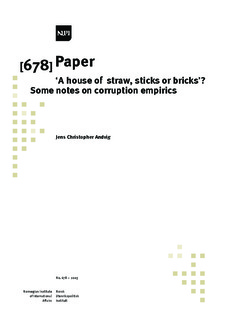| dc.contributor.author | Andvig, Jens Christopher | |
| dc.date.accessioned | 2016-07-01T12:16:33Z | |
| dc.date.accessioned | 2016-07-04T08:08:17Z | |
| dc.date.available | 2016-07-01T12:16:33Z | |
| dc.date.available | 2016-07-04T08:08:17Z | |
| dc.date.issued | 2005 | |
| dc.identifier.citation | Working Paper, NUPI nr 678. NUPI, 2005 | nb_NO |
| dc.identifier.issn | 0800 - 0018 | |
| dc.identifier.uri | http://hdl.handle.net/11250/2395390 | |
| dc.description | - | nb_NO |
| dc.description.abstract | Corruption has become a fashionable subject the last decade or so. The
decades before it was neglected, and the phenomenon itself has been around as long as
large-scale organisations. One reason for large shifts in emphasis is the lack of precise
knowledge about corruption, particularly at elite level. That admits different views. When
both social scientists’ and politicians’ perceptions are interrelated large shifts may be
expected. By comparing the major corruption indexes such as Transparency International’s
Corruption Perception Indexes to an earlier attempt to expand precise knowledge for policymaking,
I argue that they are unable to supply the knowledge needed. The difficulty in
gaining information about elite corruption is illustrated by means of simple game theory. | nb_NO |
| dc.language.iso | eng | nb_NO |
| dc.publisher | NUPI | nb_NO |
| dc.relation.ispartofseries | NUPI Working Paper;678 | |
| dc.rights | Navngivelse-Ikkekommersiell-DelPåSammeVilkår 3.0 Norge | * |
| dc.rights.uri | http://creativecommons.org/licenses/by-nc-sa/3.0/no/ | * |
| dc.title | 'A house of straw, sticks or bricks'? Some notes on corruption empirics | nb_NO |
| dc.type | Working paper | nb_NO |
| dc.date.updated | 2016-07-01T12:16:33Z | |
| dc.source.pagenumber | 41 p. | nb_NO |
| dc.identifier.cristin | 1365666 | |

